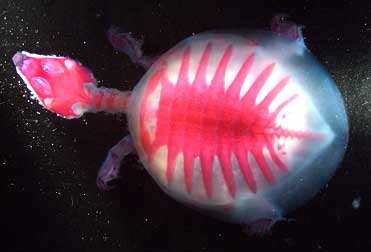| RIKEN Center for Developmental Biology (CDB) 2-2-3 Minatojima minamimachi, Chuo-ku, Kobe 650-0047, Japan |
Nagashima et al. started by looking closely at the morphology of the region where the carapacial ridge develops in the turtle and comparing it with equivalent regions in other non-chelonian amniote species, such as chicken. Observation of the period during which the ridge forms, revealed that it is an axial structure derived entirely from the somites (transient mesodermal structures that give rise to trunk skeletal muscle, vertebrae and ribs). Unlike in chicken, in which the ribs invade the lateral body wall, the ribs in P. sinensis never do so, suggesting that in turtles the ribs (and so the carapace) are confined solely to the axial domain dorsal to the embryonic flank. The group next looked at the roles of genes that had previously been shown to be expressed specifically in the carapacial ridge. They found that the introduction of a dominant negative version of the CR-specific gene LEF-1 resulted in the abnormal development of the carapacial ridge, indicating that this gene plays a role in the formation and maintenance of that structure. Turning next to classical embryology, Nagashima performed transplantation and ablation experiments to ascertain what role, if any, the carapacial ridge played in determining the turtle’s unique pattern of rib growth. Interestingly, the carapacial ridge was found frequently to regenerate and retain its axial position in embryos in which the region was cauterized at stage 14. But examination of the subsequent development of the CR-ablated embryos did show that the fan-shaped pattern of the ribs was partially disturbed. This suggests that while the carapacial ridge is not responsible for the axially restricted growth of turtle ribs, it might rather be involved in the radiation of the ribs in an arc relative to the midline. “This study showed that the turtle has not added anything new to the ancestral anatomical components—there are no turtle-specific skeletal elements,” says Kuratani. “Rather, their ribs are arrested dorsally, in their original position of development and simply grow laterally, which does not happen in other amniotes. The CR might in some way function in changing the direction of growth, but we still do not know how this might be achieved.” The lab is continuing to work on anatomical relationships between skeletal and muscle elements in the hopes of identifying the gene or regulatory system that actually altered the direction of rib growth, which will provide a better understanding of 'the making of the turtle'.
|
|||||
|
|||||
 |
| Copyright (C) CENTER FOR DEVELOPMENTAL BIOLOGY All rights reserved. |
